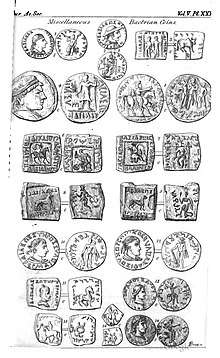Charles Masson

Charles Masson (1800–1853) was the pseudonym of James Lewis, a British East India Company soldier and explorer. He was the first European to discover the ruins of Harappa near Sahiwal in Punjab, now in Pakistan.
Early life
British by birth, Masson joined the Bengal Artillery wing of the East India Company Army in India and served in the Battle of Bharatpur.
Travels

In 1827, while stationed at Agra, he and a colleague deserted and traveled through parts of the Punjab that were under British control at that time. At Ahmadpur, they were rescued by Josiah Harlan and commissioned as mounted orderlies in his expedition to overthrow the regime in Kabul, Afghanistan. Not long afterward, near Dera Ghazi Khan, he deserted Harlan.
Between 1833 and 1838, Masson excavated over 50 Buddhist sites around Kabul and Jalalabad in south-eastern Afghanistan, amassing a large collection of small objects and many coins, principally from the site at Bagram (the ancient Alexandria on the Caucasus), north of Kabul. From 1827, when he deserted, to his return to England in 1842, it is estimated that Masson collected around 47,000 coins.
Masson was the first European to see the ruins of Harappa, described and illustrated in his book Narrative of Various Journeys in Balochistan, Afghanistan and The Panjab. He also visited the North-West Frontier Province and Balochistan, serving as an agent of the East India Company.
In the 1930s, the French Archaeological Delegation in Afghanistan (Délégation archéologique française en Afghanistan, DAFA) found unexpected evidence of an earlier European visitor scribbled in one of the caves above the 55 m Buddha at Bamiyan. This stated:
If any fool this high samootch explore,
Know Charles Masson has been here before[1]
The Masson Project at the British Museum
Through his wide-ranging travels, Masson built up an extraordinary collection of artefacts largely (although not exclusively) from the modern states of Afghanistan and Pakistan. Numbering about 9,000 objects, they are now held by the British Museum.[2] The Masson Project is led by Dr Elizabeth Errington, and aims to publish Masson's collection. Publications so far include:
Two major catalogues
- Charles Masson and the Buddhist Sites of Afghanistan: Explorations, Excavations, Collections 1832-1835, by Elizabeth Errington, British Museum Research Publication 215 (2017).[3]
- The Charles Masson Archive: British Library, British Museum and Other Documents Relating to the 1832–1838 Masson Collection from Afghanistan, by Elizabeth Errington, assisted by Piers Baker, Kirstin Leighton-Boyce and Wannaporn Kay Rienjang, British Museum Research Publication 216 (2017).[4]
Shorter articles
- E. Errington and V.S. Curtis, From Persepolisto the Punjab. Exploring the Past in Iran, Afghanistan and Pakistan (London, The British Museum Press, 2007), passim.
- E. Errington, ‘“Boots”, “female idols” and disembodied heads’, Journal of Inner Asian Art and Archaeology I (2006), pp. 89-96
- E. Errington, ‘Charles Masson’, Encyclopaedia Iranica online (2004)
- E. Errington, ‘Ancient Afghanistan through the eyes of Charles Masson: the Masson Project at the British Museum’, International Institute for Asian Studies Newsletter (March 2002), pp. 8-9
- E. Errington, ‘The collections of Charles Masson (1800-53)’, Circle of Inner Asian Art Newsletter 15 (2002), pp. 29-30
- E. Errington, ‘Discovering ancient Afghanistan, The Masson Collection’, Minerva 13/6 (2002), pp. 53-5
- E. Errington, ‘Discovering ancient Afghanistan’, British Museum Magazine 44 (2002), p. 8
- E. Errington, ‘Charles Masson and Begram’, Topoi 11/1 (2001 [2003]), pp. 357-409
- E. Errington, ‘Rediscovering the collections of Charles Masson’, in M. Alram and D. E. Klimburg-Salter (eds.)Coins, Art and Chronology. Essays on the pre-Islamic History of the Indo-Iranian Borderlands (Vienna, Österreichische Akademie der Wissenschaften, 1999), pp. 207-37
Bibliography
Books and edited volumes:
- 1843 Narrative of a journey to Kalât, including an insurrection at that place in 1840; and A Memoir on Eastern Balocistan, Richard Bentley, London.
- 1844 Narrative of various journeys in Balochistan, Afghanistan, the Panjab and Kalat 4 vols. Richard Bentley, London, (reprint, illustrated Munshiram Manoharlal Publishers, 2001, ISBN 978-8121510332.)
- 1848 Legends of the Afghan countries, in verse, James Madden, London.
Articles:
Further reading
- Whitteridge, Gordon: Charles Masson of Afghanistan : explorer, archaeologist, numismatist and intelligence agent (Warminster : Aris & Phillips, 1985).
- Errington, Elizabeth, and Curtis, Vesta Sarkosh (eds): From Persepolis to the Punjab: Exploring Ancient Iran, Afghanistan and Pakistan (London: British Museum Press, 2007; reprinted 2011).
- Iranica-Article
- Ben Macintyre, The Man Who Would Be King: The First American in Afghanistan. New York: Farrar, Straus and Giroux, 2004. ISBN 0-374-20178-1
- Charles Masson's Harappa
- Charles Masson. Narrative of Various Journeys in Balochistan, Afghanistan and The Panjab. ISBN 978-8121510332
- Charles Masson of Afghanistan: Deserter, Scholar, Spy Biographical article by Bijan Omrani.
- A chapter describing Charles Masson's role in the 1840 siege of Kelat
See also
References
- ↑ Elizabeth Errington, "Ancient Afghanistan through the Eyes of Charles Masson (1800-1853): The Masson Project at the British Museum", IIAS Newsletter no.27, pp.8-9
- ↑ British Museum Collection
- ↑ https://www.oxbowbooks.com/oxbow/charles-masson-and-the-buddhist-sites-of-afghanistan.html
- ↑ http://www.britishmuseum.org/pdf/Masson%20archive%20Vol.%202.pdf